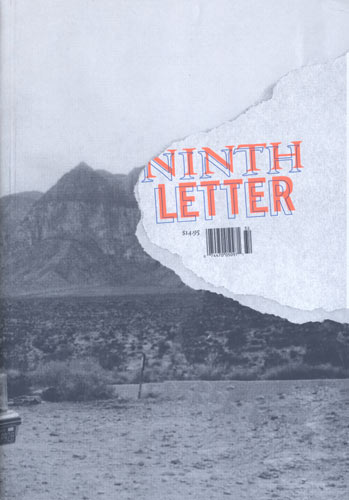Ninth Letter – Spring/Summer 2018
The Spring/Summer issue of Ninth Letter is flashy, streaked through with fluorescent orange, graphic illustrations, and altered photographs. A self-described “collaborative arts and literary project,” the journal, which is based out of the University of Illinois at Urbana-Champaign, connects art and design students with the MFA in Creative Writing program. The result is a fully-rounded version of the typically literature-dominated student-run journal.
The Spring/Summer issue of Ninth Letter is flashy, streaked through with fluorescent orange, graphic illustrations, and altered photographs. A self-described “collaborative arts and literary project,” the journal, which is based out of the University of Illinois at Urbana-Champaign, connects art and design students with the MFA in Creative Writing program. The result is a fully-rounded version of the typically literature-dominated student-run journal.
The skilled, aggressive design team is sometimes over-exuberant—for example, the nonfiction category in the table of contents is inverted—but the visual impact of their work is largely positive, an energetic boost that keeps things fresh irrespective of the text it abuts. The journal is separated by category: blocks of nonfiction, poetry, and fiction, followed by a staff column. The nonfiction is solid, but the clear standout is “The Genealogy of a Killer” by Misha Rai.
In her piece, Rai explains that when she was not quite a year and two months old, her parents brought home a bundle of blankets and introduced it as “brother.” At the time, she didn’t understand, was irritated by her displacement, and though this story is familiar to countless older, aggrieved siblings, the author’s reaction was a touch more malevolent than the average tantrum: her remedy was murder. Murder with knitting needles, a push down the stairs, a near-drop from a window. She failed. Then, everything changed. Rai writes:
When your brother’s clothes, layers of them, came off in front of you for the first time [ . . . ] you hugged him chest to chest, you pinched your forearm and then your brother’s, making him wail, and gleefully laughed, “Like me!”
Her story, which is charming and disturbing all at once, is complicated enormously by the actions her mother takes years later, having bottled up the fatigue and fury of policing her daughter and preserving her young son’s life. Closure is the antidote for mother and daughter alike, but it is elusive, slippery, just beyond reach, and yet hopefully, one day, attainable.
The issue’s best poetry comes from a similar psychic space, dark observations offset by pith or hope or tenderness. “Noon” by Megan J. Arlett, a poem about men who leave their dogs outside to suffer in unforgiving heat, reads:
I say this
because I’ve heard plants enjoymelody over agony. I say this because
plant air is our air
is dog air.
In “Airplanes,” Maggie Smith’s speaker worries over a three-year-old son, thinking about the children shot dead the past year, even though her own child is white and, therefore, likely safe. She writes:
[ . . . ] My son
is sprawled on his back, arms flungdon’t shoot wide. This year
I was in none of the pictures& yet I am in all of them.
That’s me, there, the shadowthat shielded his eyes each time
the year shot anothermother’s son in the street.
Strong too are “Forgive Me, I Am a Violent Shape” by Reese Conner, a poem that grapples with hunting, and “Homecoming” by John Sibley Williams, which centers on tough feelings called forth by a soldier’s funeral. He writes:
Goddamn the
x-rayed December trees, the bullet
still lodged in the skull of night, this
shovel-breaking earth we break &
drape in stars, stripes.
The issue’s fiction is more of a mixed bag. “The Temple of Suzee Pai” by Ari Laurel reads like an over-researched memoir piece until its final paragraphs, when a twist ending sells it definitively as fiction. “The Logicians” by James Warner, a former philosopher, is frustrating, dependent on niche humor and the reader’s patience, as well as a few gimmicky elements. Luckily, “Fennimore” by Katherine Zlabek, the piece that follows, is more compelling. Its protagonist is Marigold, a woman in the midst of a decision about an unfulfilling relationship. Eventually, she allies herself with a flailing artist in a similar funk.
Finishing up the section is “Host” by Patrick Nathan, a story about a trans woman who struggles to be accepted. The protagonist, Margot, is supported by her younger roommate, a perfectionist who is used to achieving her goals but is nevertheless hurtling toward her first significant failure. In a poignant moment, Margot, who works at night and prefers how small the world seems in those hours, returns home: “Her roommate was on the balcony,” Nathan writes, “watching the sun ruin everything.”
Suns aside, Ninth Letter is a fun project that ticks all the normal lit journal boxes while providing energy and flash where other journals play it low key. It is the small details, the design flourishes, the little orange bursts throughout the issue that enhance the experience and make it memorable. Many of the pieces in this issue are morbid or unflinching, but light can be mined from the dark, and some of the most vital lessons come from the hardest moments. The current issue of Ninth Letter provides plenty of each.
[www.ninthletter.com]





